2d Evacuation Hospital Unit History

Group of Officers and Enlisted personnel of the 2d Evacuation Hospital, Ft. Devens, Ayer, Massachusetts. Picture taken in January 1942, with Lt. Colonel Eli E. Brown, Commanding, surrounded by his staff and personnel. Corporal Lawrence F. Salamone, Sr., is the fourth person from the left in the front row (photo courtesy Mike Salamone).
Introduction:
The story of the Second Evacuation Hospital already began in World War 1. The unit was constituted in the A.E.F. as Evacuation Hospital No. 2. It was activated at Fort Benjamin Harrison, Indianapolis, Indiana, the same day on 20 July 1917, and served overseas in France figuring in the Meuse-Argonne Offensive. The Hospital was demobilized at Camp Taylor, Kentucky, on 7 May 1919. When the dark clouds of war AGAIN descended upon Europe in those black days of September 1939, plans were instituted at St. Luke’s Hospital, New York City, to re-activate the unit (reconstituted 21 December 1928 in the Regular Army, Ref. 320.2 Medical Department (11 Dec 28), Miscellaneous C, dated 21 Dec 1928, AG 320.2 (19 Oct 36), Miscellaneous (Ret), dated 5 November 1936 –ed). The Surgeon’s Office in Washington directed that Officers and Nurses be recruited and an affiliated 750-bed Evacuation Hospital organization formed.
Activation & Organization:
Dr. Paul C. Morton, Attending Surgeon, initiated discussions concerning the possibility of organizing an affiliated Army hospital unit at St. Luke’s Hospital, New York City, N.Y. On 11 September 1939, a letter was addressed to The Surgeon General to learn the US Army’s attitude regarding such undertaking. After receiving an encouraging reply, The Surgeon General’s Office formerly requested the formation of such hospital unit in March 1940. It was planned to start a 750-bed mobile unit, in fact an Evacuation Hospital, for functioning in a combat zone. The personnel of such organization would consist of 40 Officers, 60 Nurses, and 300 Enlisted Men. The letter and contents were read to St. Luke’s Medical Board and subsequently approved.

Group of Commissioned Officers and Nurses of the 2d Evacuation Hospital, Ft. Devens, Ayer, Massachusetts. Picture taken in January 1942, with Lt. Colonel Eli E. Brown, Commanding (photo courtesy St. Luke’s & Roosevelt Hospitals, New York).
From L to R:
Front Row – Seated > Major John P. West, Major Warren B. Spurge, Major William H. Berry, Major Charles R. Munson, Major Morris K. Smith, Lt. Colonel William F. MacFee, Lt. Colonel Eli E. Brown, Captain Margaret D. Prietzel, Major John S. Davis, Major Paul C. Morton, Captain John R. Palmer, Major Ryle A. Radke, 1st Lt. Walter J. Thomas.
Second Row > 2d Lt. H. Cameron, 2d Lt. Margaret N. Gorton, 2d Lt. E. Cuncan, 2d Lt. Blanche E. Bremer, 2d Lt. Lydia M. Domert, 2d Lt. Harriet C. Muff, 2d Lt. Rose M. Phillips, 2d Lt. Florence C. Jennings, 2d Lt. Marguerite Hoffman, 2d Lt. Margaret A. Tucker, 2d Lt. Marion F. McClelland, 2d Lt. Ruth E. Collins, 2d Lt. Mary S. Nelson,
2d Lt. Gertrude E. MacNeil, 2d Lt. Josephine R. Neglia, 2d Lt. Phoebe J. Campbell, 2d Lt. Olga Schott, 2d Lt. M. Higgins, 2d Lt. G. Quigley, 2d Lt. Ruth L. Potter, 2d Lt. Olive C. Thompson, 2d Lt. Anna C. Kerker, 2d Lt. B. Cook, 2d Lt. Ebba R. Sodemann.
Third Row > 2d Lt. E. Supek, 1st Lt. Robert W. Fraser, unknown, 1st Lt. Herbert Wright, Captain William S. Norton II, 1st Lt. Hector Perrone, Captain R. Holmes (Chaplain), 1st Lt. George A. Falkner, Captain Charles M. Brane, Captain Robert L. Ward, 1st Lt. George G. Hollins, unknown, 1st Lt. Herbert Parsons, 1st Lt. D. Roberts, Captain Sawnee R. Gaston, Captain Gerald D. Dorman, unknown, 1st Lt. John J. Ceravolo, Captain Boardman M. Bosworth.
Fourth Row > 2d Lt. T. Papineau, 2d Lt. E. Palmer, 2d Lt. Leona Edwards, 2d Lt. Florence R. Hawkes, 2d Lt. Rae E. Morse, 2d Lt. Sarah C. Cuddeback, 2d Lt. Ruth E. Varnum, 2d Lt. Kathrin Dewey, 2d Lt. Helen J. Burdett, 2d Lt. Alice H. Allen, 2d Lt. Hildred S. Merrihue, 2d Lt. Jean E. Hower, 2d Lt. Ann Slocum, 2d Lt. Edith G. Byram,
2d Lt. Nell L. Fountain, 2d Lt. Janice E. Freeman, 2d Lt. Catherine H. Phyfe, 2d Lt. Wilda A. Miller, 2d Lt. M. Byram, 2d Lt. Ruth H. Meinecke, 2d Lt. M. Brennan, 2d Lt. Anna Magera.
Rear Row > 2d Lt. Z. Pineau, 2d Lt. Ellen A. Greene, 1st Lt. L. Shankman, 1st Lt. Richard Allyn, 1st Lt. Benneth R. Berkhausen, unknown, unknown, 1st Lt. Edward C. Stillwell, 1st Lt. George E. Gerkin, 1st Lt. Robert Birchall, 1st Lt. C. Lang, 1st Lt. Herbert Wright, 1st Lt. Hubert C. Patterson, 1st Lt. Donald F. Brayton, 1st Lt. J. Mulholland, 1st Lt. Charles F. Schetlin, 1st Lt. William H. Vail II, 1st Lt. Francis W. Doucett, 2d Lt. John T. Walke, 2d Lt. M. Masterson, 2d Lt. Mavis Field, 2d Lt. Marie J. Brown.
On 27 December 1941, the unit was alerted to an early call for active duty. The Board of Managers then passed a resolution at its meeting of 29 December granting a blanket leave of absence to those members of the medical staff who would leave for service with the 2d Evacuation Hospital.
On 9 January 1942, individual members of the new unit received orders to report on 21 January 1942, for active duty, to Fort Devens, Massachusetts, where they would begin Army training.
On 22 January 1942, the 2d Evacuation Hospital was officially activated at Fort Devens, Ayer, Massachusetts (11,796-acre Military Reservation –ed) as per AG 320.2 (6 Jan 42), MR-M-C, dated 15 January 1942, General Orders No. 7, Headquarters, First Corps Area, Boston, Massachusetts, 23 January 1942, Letter 2d Evacuation Hospital, Ft. Devens, Massachusetts, dated 7 February 1942, where the new staff was ordered to report to Captain Ryle A. Radke of the 4th Evacuation Hospital.
The unit’s Medical Officers were all nominated by St. Luke’s from its own staff, or from the membership of The Society of Alumni of St. Luke’s Hospital House Staff, with only one exception.
| Preliminary Medical Staff – 2d Evacuation Hospital | |
| Lt. Colonel William F. MacFee (Unit Director & Chief of Surgical Service) | |
| Lt. Colonel John S. Davis, Jr. (Chief of Medical Service) | |
| Major William H. Berry | Major Duncan R. McCuaig |
| Major Paul C. Morton | Major Charles R. Munson |
| Major John R. Palmer | Major Morris K. Smith |
| Major Warren B. Spurge | Major John P. West |
| Captain Charles M. Brane | Captain John J. Ceravolo |
| Captain Gerald D. Dorman | Captain George A. Falkner |
| Captain Robert W. Fraser | Captain Sawnie R. Gaston |
| Captain George G. Hollins | Captain Horace Leigh |
| Captain William S. Norton, II | Captain Herbert Parsons |
| Captain Hector Perrone | Captain Robert L. Ward |
| Captain Thomas C. Worth | Captain Myron Wright |
| First Lieutenant Richard Allynn | First Lieutenant Bennett R. Berkhausen |
| First Lieutenant Robert Birchall | First Lieutenant Hubert C. Patterson |
| First Lieutenant Charles F. Schetlin | First Lieutenant Edward C. Stillwell |
| First Lieutenant William H. Vail, II | First Lieutenant Herbert Wright |
After the unit’s arrival at Fort Devens it was placed under Lt. Colonel Eli E. Brown, an Officer of the regular Army, appointed as Commanding Officer. Captain Ryle A. Radke, was soon designated Executive Officer. This Officer came from the 4th Evacuation Hospital (a non-affiliated unit, activated 10 Feb 41, which supplied Enlisted cadre personnel for affiliated Evac Hosp units). The EM cadre was further augmented by assigned personnel from Camp Barkeley, Texas (Armored Division Camp –ed), which provided another 174 men, supplemented by another 137 EM transferred from the 4th Evacuation on 16 February. By 14 March 1942, the organization was completely staffed through the addition of 5 physicians assigned by the Army. On 27 March 1942, Colonel E. I. Brown was relieved of his post by Colonel James N. Williams, MC, who became the new CO 6 April 1942 (coming from LaGarde General Hospital, New Orleans, Louisiana). Lt. Colonel W. F. MacFee remained with the unit as Chief of Surgical Service, while Lt. Colonel J. S. Davis, Jr. continued as Chief of Medical Service.

Layout of 2d Evacuation Hospital, illustrating Receiving, Operating, and Ward Tents (original drawn 10 April 1943).
The unit’s Enlisted personnel was temporarily housed in the red brick buildings comprising the Fort Devens Quadrangle; Officers and Nurses were quartered at Lovell General Hospital. On 20 February 1942, the EM moved to cantonments, directly opposite Lovell.
On 17 May 1942, Major R. A. Radke was transferred to The Surgeon General’s Office in Washington D.C., and replaced by Major Paul C. Morton, MC, who was appointed Executive Officer. Two Officers were transferred to the Air Corps as Flight Surgeons, the Detachment Commander went to the 83d Infantry Division, and 27 Enlisted Men successfully qualified for various OCS Schools. Other sources from which personnel were obtained included Camp Barkeley, Camp Lee, Lovell General Hospital, and Fitzsimons General Hospital.
Margaret D. Prietzel, RN, a graduate of St. Luke’s was designated as Chief Nurse of the new unit. All Nurses joining the Hospital were graduates of St. Luke’s School of Nursing. A considerable number of them volunteered directly while others came from St. Luke’s private duty group and others from employment outside. The ANC staff arrived for duty on 31 January 1942.
| Preliminary Nursing Staff – 2d Evacuation Hospital | |
| First Lieutenant Margaret D. Prietzel (Chief Nurse) | |
| Second Lieutenant Alice H. Allen | Second Lieutenant Blanche E. Bremer |
| Second Lieutenant Marie J. Brown | Second Lieutenant Helen J. Burdett |
| Second Lieutenant Edith G. Byram | Second Lieutenant Phoebe J. Campbell |
| Second Lieutenant Ruth E. Collins | Second Lieutenant Sarah C. Cuddeback |
| Second Lieutenant Kathrin Dewey | Second Lieutenant Lydia M. Domert |
| Second Lieutenant Leona Edwards | Second Lieutenant Mavis Field |
| Second Lieutenant Nell L. Fountain | Second Lieutenant Janice E. Freeman |
| Second Lieutenant Margaret N. Gorton | Second Lieutenant Ellen A. Greene |
| Second Lieutenant Florence R. Hawkes | Second Lieutenant Marguerite Hoffman |
| Second Lieutenant Jean E. Hower | Second Lieutenant Florence C. Jennings (*) |
| Second Lieutenant Eleanor C. Jones | Second Lieutenant Anna C. Kerker |
| Second Lieutenant Anna Magera | Second Lieutenant Gertrude E. MacNeil |
| Second Lieutenant Marion F. McClelland | Second Lieutenant Ruth H. Meinecke |
| Second Lieutenant Hildred S. Merrihue | Second Lieutenant Wilda A. Miller |
| Second Lieutenant Rae E. Morse | Second Lieutenant Harriet C. Muff |
| Second Lieutenant Josephine R. Neglia | Second Lieutenant Mary S. Nelson |
| Second Lieutenant Rose M. Phillips | Second Lieutenant Catherine H. Phyfe |
| Second Lieutenant Ruth L. Potter | Second Lieutenant Ann Slocum |
| Second Lieutenant Ebba R. Sodemann | Second Lieutenant Olive C. Thompson |
| Second Lieutenant Margaret A. Tucker | Second Lieutenant Ruth E. Varnum |
| (*) 2d Lt. F. E. Jennings, already serving with the ASF, was transferred from Stark General Hospital, Charleston, South Carolina, ZI. | |
| Top |
Training:
Between January and June 1942, the personnel of the unit underwent intensive military training, with little or no medical work.
A benefit concert for the 2d Evacuation Hospital was held on 24 March 1942, to provide a fund to be used for or by the organization. By means of this concert and through direct donations, a sum of US$ 4,397.00 was raised. Of this money, $ 3,034.31 was spent to provide special instruments and apparatus for the Hospital’s work.
During the early formative days, daily classes on customs of the service, military courtesy and discipline, orientation lectures, drills and hikes were conducted. After 10 March 1942 Officers, Nurses, and Enlisted Men were sent to work in Lovell General Hospital, Ayer, Massachusetts, and to the new Station Hospital located on the Post, to acquire some experience in the wards and in the operating rooms. Additional classes dealing with first-aid, hygiene, sanitation, hemorrhage control, arm and leg splints application, and other materia medica, etc. were taught. Long marches with full equipment were held for hardening the men.
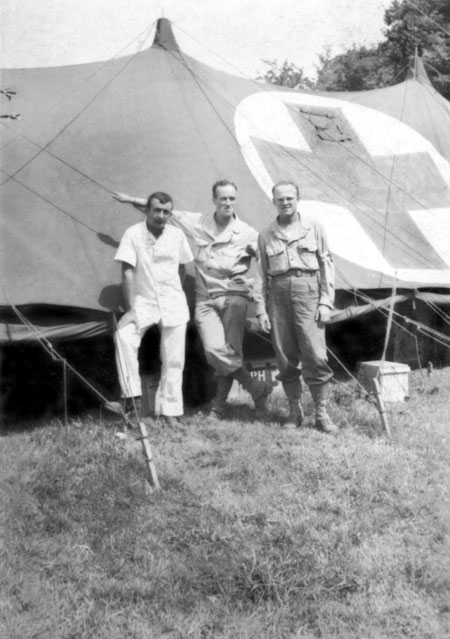
Some of the Hospital’s personnel in front of one of the ward tents. Picture taken in summer of 1943, during the unit’s stay in England. Corporal Lawrence F. Salamone, Sr., is on the left dressed in white (photo courtesy Mike Salamone).
On 17-18 June 1942, the Inspector General’s Office, VI Army Corps, conducted a thorough inspection of the unit’s equipment and records, which received a ‘Very Satisfactory’.
As per T/O 8-580, dated 2 July 1942, the authorized strength for an Evacuation Hospital was 47 Officers – 52 Nurses – and 318 Enlisted Men. Such numbers were not attained by the 2d Evacuation Hospital prior to its movement for overseas service (in May-June 1942, the organization only consisted of 38 Officers, 41 Nurses, and 311 Enlisted personnel).
Preparation for Overseas Movement:
On the morning of 21 July 1942, the organization departed from Fort Devens on a change of station, preparatory to movement overseas. Destination was Camp Kilmer, Stelton, N.J. (staging area for New York POE –ed). Camp Kilmer was immense; buildings at the time were new with some still under construction. They were camouflaged in reds, yellows, and greens, to represent civilian villages. But the nicest thing about the area was its close proximity to cities like New York and Philadelphia.
During the unit’s stay at Camp Kilmer, individual clothing and equipment was checked and re-checked; physical inspections and gangplank exercises were conducted; embarkation rosters were prepared; and no one can forget that memorable night the men were roused from sleep to have their individual photographs taken for Geneva Convention ID cards purposes! There was also another incident with a 10-day quarantine imposed when one of the men became ill with meningitis. Fortunately there were no further outbreaks. Normal garrison duties prevailed during the organization’s stay at Camp Kilmer.

Corporal Lawrence F. Salamone, Sr, working in the Hospital’s Laboratory. Picture taken during the unit’s stay in Diddington, England, from 26 December 1942 until 1 August 1943 (photo courtesy Mike Salamone).
Overseas Voyage:
On 4 September 1942, the 2d Evacuation Hospital left Camp Kilmer for the New York Port of Embarkation. The unit boarded the “Queen Mary” the same day in the evening – this was a big moment in everyone’s life! The Hospital was going overseas! Although the destination was officially unknown (censorship), many were inclined to guess that it would probably be the British Isles.
The following day, 5 September 1942, the “Queen Mary” put to sea. There were lots of dry throats as the Statue of Liberty faded into the distance; the ship was leaving safety of land behind; ahead was the large expanse of cold, blue-green water of the Atlantic, and lurking in its waters were German U-boats, always on the prowl for troop and cargo ships.
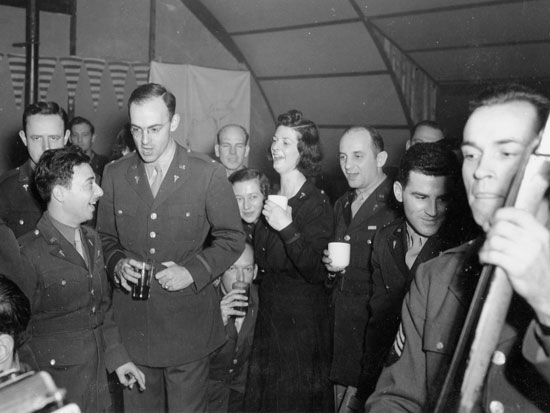
New Year’s party organized by the 2d Evacuation Hospital while stationed in Diddington, England. Picture taken 31 December 1942 (photo courtesy VMI Archives).
The sea voyage was a new and thrilling experience to the majority of the personnel. Although the boat was crowded with troops and the danger from enemy submarines was always present, the trip was uneventful and pleasant. Boat and air raid drills were held daily, and at night the entire ship was blacked out. The realization that such instructions were necessary for preventing loss of lives prompted everyone to comply with the orders.
United Kingdom:
After a voyage of 5 ½ days, the “Queen Mary” anchored at Greenock, Scotland, 11 September 1942. The place looked picturesque and peaceful, though barrage balloons stretched up into the sky, hanging there like lazy sausages above the cluster of white and red houses situated near the shores of the Clyde River. In the distance, the hills of Scotland loomed darkly against the sky, creating an unforgettable journey.
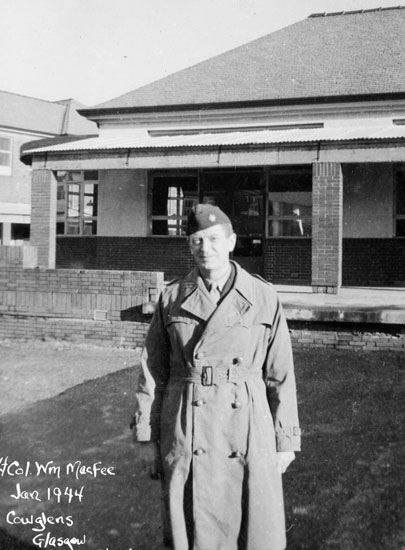
Photo of Lt. Colonel William F. MacFee, Chief of Surgery Service, 2d Evacuation Hospital. Taken in Cowglen, Scotland, January 1944, some time before being appointed Commanding Officer (10 February 1944), (photo courtesy VMI Archives).
The troops were then transferred to a ferry boat called “Princess Maud” and after crossing the North Channel, docked at Belfast, Northern Ireland, the following morning where everyone had their first glimpse of war, bomb-damaged buildings. From there on, the Nurses were sent to Waringfield, Down, for duty with the 2d General Hospital, while the rest of the organization, Officers and Enlisted Men, entrained for the Replacement Depot # 1 at Ballymena. They met their first British soldiers and ATS girls and found their accent quaint and amusing, much as the British found the Yanks’ speech funny. Soon however, everyone started detesting the rain and fog which seemed to dominate the weather.
During the unit’s stay in Northern Ireland, Headquarters were maintained at Ballymena. Various Officers, Nurses, and Enlisted personnel were placed on DS for periods of time at the 5th General Hospital (affiliated to Harvard University, Boston, Massachusetts, activated 3 Jan 42, embarked for Northern Ireland 19 Feb 42 –ed) in Belfast, the 2d General Hospital (affiliated to Presbyterian Hospital, New York, N.Y., activated 31 Jan 42, embarked for England 1 Jul 42 –ed) in Waringfield, and the 160th Station Hospital (activated 1 Jun 41, embarked for England 5 Aug 42 –ed) in Irvinstown. The equipment of the 2d Evacuation Hospital which had been assembled at home and brought over with the command was now shipped to a central supply depot in England where it was further prepared for use in the Invasion of North Africa on 8 November 1942 (Operation “Torch” –ed).
On 26 October 1942, two groups of personnel were sent on Detached Service; one, consisting of 12 Officers – 20 Nurses – 70 Enlisted Men, under command of Major Wiliam H. Berry, to Frenchay Park Military Hospital, Bristol to take over from the 77th Evacuation Hospital (affiliated to University of Kansas, Kansas City, Kansas, activated 10 May 42, embarked for England 5 Aug 42 –ed); the other group of 8 Officers – 12 Nurses – 40 Enlisted Men, under Major Charles R. Munson, went to Musgrove Military Hospital, Taunton, to relieve the 180th General Hospital. On 6 November 1942, Headquarters with the rest of the organization’s personnel followed to Norton Manor Camp, in Taunton. The reason for taking over other hospitals was to relieve units sailing for North Africa.
At Frenchay Park, Major W. H. Berry’s group found itself caring for 150 patients with one third the personnel of their predecessors. There were no insoluble problems, however, and they left with some regret on 13 November, after being relieved by the 298th General Hospital (affiliated to University of Michigan, Ann Harbor, Michigan, activated 27 Jun 42, embarked for England 20 Oct 42 –ed), to join Major C. L. Munson’s group in Taunton. The long period of waiting for an active assignment had been rather discouraging to morale and while those engaged at Musgrove Hospital were happy doing their work, there was a general feeling of satisfaction and relief when orders came to transfer the entire organization to a new hospital site with the prospect of receiving and caring for their own patients within a short time. In the meantime, this was 5 December 1942, the 67th General Hospital (affiliated to Maine General Hospital, Portland, Maine, activated 1 Sep 42, embarked for England 24 Nov 42 –ed) arrived at Taunton to take over Musgrove Hospital. On 7 December, the whole unit finally proceeded to Diddington, Huntingdonshire, England.

Wedding ceremony of Captain Charles F. Schetlin, MC, and First Lieutenant Mary S. Nelson, ANC. The couple is coming out of church. Scotland, 18 January 1944 (photo courtesy George G. Nelson, Jr.).
First Operations
Here in the Eighth United States Army Air Force area, a 750-bed Station Hospital of Nissen Huts was nearing completion by the British under specifications of the US Army Medical Department. Although early finalization was expected, there were delays in getting the installations ready. The two most serious problems were the water supply and the sewage system both of which were undergoing extensions to meet the Hospital’s necessities. Supplies, both general and medical, were still incomplete, and some more difficulties arose with the installations for equipment, as some of them were British and some American.
On 26 December 1942, the 2d Evacuation Hospital was officially opened to receive patients of the Eighth Army Air Force, who had previously been cared for in local EMS and British RAF Hospitals. An order to this effect was published and circulated by the Chief Surgeon’s Office, Headquarters, ETO, as well as by the United States Army Air Forces Command to surrounding airbases. Quite a few airfields were located around the organization’s site and the personnel became fascinated by the high-flying B-17 Fortresses on their way to and from the continent on bombing missions. As of midnight 31 December 1942, the Hospital had 80 patients in its wards. For several months, the 2d Evac was the ONLY American Hospital in the vicinity servicing the Eighth AAF.
The Hospital’s location was however distant from outside recreational facilities. Under the auspices of the Special Service, the ARC, the USO, and the RAF, this lack was amply met with four moving pictures a week and a fortnightly show. Highlights were visits by Bob Hope and Frances Langford. In addition there were monthly dances for the Enlisted Men to which WAAFS, ATS, and civilian girls were regularly invited. Tours and visits to London and Cambridge by train were equally organized, and each evening Liberty trucks were dispatched to nearby Huntingdon.
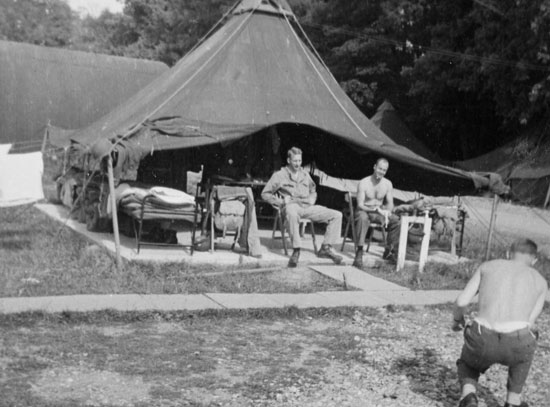
Hospital personnel relaxing before the move to the continent. Picture taken in front of one of the unit’s pyramidal tents, at the Henley-on-Thames Concentration Area, England, 10 June 1944 (photo courtesy VMI Archives).
Beginning 15 January 1943, weekly professional meetings were held which were well attended by Medical Officers from surrounding airfields. Speakers were partly members of the professional staff who presented topics from the experience gained by the 2d and in part invited guests, both American and British, who contributed many interesting addresses on medical subjects. The local civilian police provided some lectures on German bombs, disposal of explosives, and how to deal with air raids and attacks.
During spring, 3 American Red Cross workers were attached to the unit and took time to organize a much appreciated recreation room for the patients.
There was an accidental bomb explosion at a nearby airfield on 27 May 1943. 14 casualties caused by the incident were admitted, among which several severely injured. Quick treatment and surgical care helped them survive and the unit received a well-earned Letter of Commendation from the 8th USAAF for the splendid way in which the emergency was handled.
The seven months of service (26 Dec 42 > 1 Aug 43) at Diddington embraced the most important part of the 2d Evac’s contribution to the war effort for the year 1943. The organization functioned largely as a Station Hospital with the privilege of doing elective surgery, but also serving in the capacity of an Evacuation Hospital for many AAF wounded returning from bombing missions over the continent and Germany. Battle casualties during this period constituted 4.3% of admissions, a small, but very important group. Wounds were nearly always multiple, mostly caused by explosive shells, often 20mm flak, with wounds of the extremities accounting for about 60%, head and face injuries representing 20%, chest 10%, and abdomen also 10%. Because casualties were treated in a few hours after injury – rarely more than 4 or 5 hours later – before going into the OR, the wounds after careful debridement, could be sutured and would heal without infection. During the above period, 4,625 admissions of whom 56% were from the Army Air Forces and a further 40% from the Corps of Engineers, the Medical Corps, the Ordnance Corps, the Quartermaster Corps, the Military Police, the Signal Corps, and the Chemical Warfare Service; largely if not entirely serving the Eighth Army Air Forces, totaling 97% of the patients. Of those discharged, 86% were returned to duty and 13% transferred to other Hospitals for further treatment or disposition. There were 9 deaths. The OR staff handled 1,921 cases.
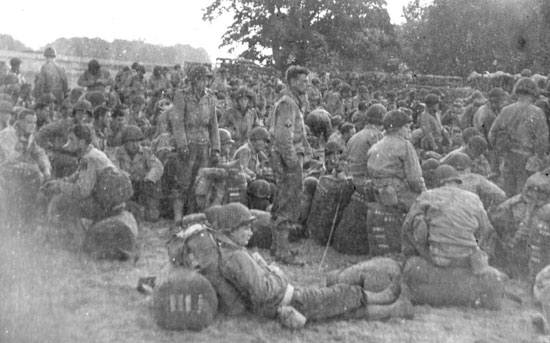
Hursley Marshaling Area, England, 19 June 1944. Early in the morning, it is cold and windy and men of the Detachment are awaiting transportation (photo courtesy VMI Archives).
At the end of the first week in August 1943, movement orders were received to proceed by train to Glasgow, Scotland. On 9 August the organization left Diddington (taken over by the 49th Station Hospital –ed) and proceeded to Crookston Camp, Glasgow, where, near a camp of scattered Nissen huts on the outskirts of town, a Hospital was set up under rather trying conditions. Patients were received from units in the vicinity and from those passing through the port. Training was reviewed, and physical condition stressed, resulting in frequent exercises, drills, and hikes. After this short change of station, the unit received its Evacuation Hospital equipment, which had been crated ready for overseas shipment.
On 1 September 1943 the 2d Evacuation Hospital began to receive patients at Crookston Camp from American installations. At first they were few in number but soon began to increase rather rapidly by mid-October.
On 25 October 1943, the Hospital moved to Cowglen, Lanarkshire (about one mile away) where advance parties had been getting things in readiness. The 2d took over a hospital intended for contagious diseases still under construction (former EMS facility acquired by the US Medical Department in mid-1943 –ed); here they handled 2,498 patients, most of which were admitted directly from incoming convoys. One of them died. There were no battle casualties among the patients. Meanwhile hutments were constructed to quarter the Nurses and Enlisted personnel. The 50th General Hospital (affiliated to Seattle College, Seattle, Washington, activated 4 Sep 42, embarked for England 29 Dec 43 –ed) would eventually take over the site to operate an Air Evacuation Holding Unit later expanding to 1000 beds, to support the Air Transport Command evacuation facility at Prestwick.
The patient census increased, with each convoy that arrived in port. From 1 September until 25 October 1943, 291 patients had been received at Crookston; from 25 October until midnight 31 December 1943, 1,517 patients were admitted to Cowglen, of which 235 were still in hospital at the beginning of 1944.
Excellent social activities were discovered in Glasgow and nearby Edinburgh and with plenty of transportation (many streetcar and bus lines), moving was made easier. Theaters and dance halls abounded in the city and a large American Red Cross club was open to both soldiers and sailors.
On 22 December 1943, Lt. Colonel Walter G. Maddock, MC, O-401738, took over command from Colonel J. N. Williams (CO since 20 Mar 42 –ed) who went to the 52d General Hospital for a careful check-up of his physical condition which had become impaired. The new Commanding Officer was an experienced leader, having organized the 298th General Hospital which he accompanied overseas as its Chief of Surgery and Executive Officer. The newly appointed CO did not remain long with the unit however (new assignment to Headquarters, Southern Base Section, ETOUSA –ed), and on 10 February 1944, Lt. Colonel William F. MacFee, MC, O-404827, Chief of Surgery since the unit’s inception, assumed command.

Omaha Beach, 23 June 1944. A few members rest on top of a hill after having landed by LCI the same day (photo courtesy VMI Archives).
At 1645 hours, 13 February 1944, 3 Officers and 35 EM departed from Cowglen, Scotland, to prepare for the unit’s arrival at Whitchurch in South Wales. After entraining at Glasgow, the bulk of the unit arrived at Whitchurch, near Cardiff, Glamorganshire, South Wales, at 1140 hours, 17 February. Instead of moving into barracks, everybody was billeted in private homes. In the meantime, many of the personnel were on TDY with other units. Only a detail consisting of 1 Officer and 40 Enlisted Men remained behind and later re-joined the organization at Remenham, Berkshire, England on 11 June 1944. Men were now busy making boxes and crates, and others were trying to acquire speed and finesse in pitching and taking down tents, invasion talk was widespread and dominated all conversations…
Many visits were made to other Evacuation Hospitals which had seen service in the Mediterranean in order to learn as much as possible from their experience. Plans were drawn for a tented hospital and practice set-ups carried out. Model ward tents were also prepared and equipped and a uniform system of packing and crating was worked out. On 28 March 1944, Colonel John A. Rogers, Chief Surgeon, First United States Army, inspected the unit and afterwards gave a short talk to the Officers and Nurses with regard to forthcoming operations on the continent.
On 25 May, Lt. Colonel W. F. MacFee left on detached duty for 30 days with Headquarters personnel of the First US Army and Lt. Colonel John S. Davis, Jr., MC, Chief of Medical Service, assumed temporary command.
Finally, on 10 June 1944, the 2d Evac received new orders with enthusiasm and entrained at 1030, the same day, for the concentration area at Remenham, Henley-on-Thames. The stay was short and at 1230 hours, 19 June 1944, the Hospital was once more on the move to Camp Hursley Marshaling Area, England, where it arrived around 1600 hours. Processing at the camp was swift, methodical, as everyone already entrucked the following day heading for the Southampton docks. After being re-grouped and duly processed, a partial payment worth US$ 4.00 was received in French Invasion currency.
France:

Partial view of the Hospital installations at La Mine, France. Picture taken in June-July 1944. From L to R: Enlisted Men’s Mess tents, EM and Officers’ Kitchen, Officers’ tent, Mail tent & Detachment Headquarters, Patient’s Kitchen & Mess tents, Enlisted personnel pup tents in the rear (photo courtesy VMI Archives).
On 19 June 1944the organization boarded the S/S “Léopoldville”, a former Belgian passenger ship, to cross the Channel. The time was 1600. The ship sailed at 2130 hours and lay off the Isle of Wight that night and the following days. She only started crossing 22 June 1944, but because of rough seas debarkation at Omaha Beach was impossible. After transferring onto LCIs the unit eventually landed on Omaha Beach at 0800, 23 June 1944, from where it marched some two miles and assembled in a grove where ambulances and trucks drove up to transport them to the 24th Evacuation Hospital bivouac area, near La Cambe, Normandy at 1645 hours. En route, the unit was visited by Colonel William F. MacFee (recently promoted) who had reached Omaha Beach on a Hospital Carrier on D+1.
After three days with the 24th Evacuation Hospital, a housekeeping bivouac was set up in the vicinity of La Cambe and the equipment which had arrived at the Beachhead was collected and brought over; losses in transit were estimated at about 5%.
On 28 June 1944, the organization moved to an excellent location near La Mine, where it established its first 750-bed Evacuation Hospital under canvas. The site was excellent, level and well-drained, and the 20 cross-connected tents were gradually set up for receiving, pre-op, shock, x-ray, lab, disposition and central supply, nicknamed by everyone “Radio City”. The area was surrounded on all sides by big guns which let loose at all intervals, day and night. German planes would be on the prowl at night and in the distance the personnel could hear the rumble of artillery. The 2d was only within five miles of the frontlines. The 2d Evac opened for patients at 1800 hours, on 29 June 1944. Colonel W. F. MacFee returned and resumed command on 1 July 1944. For operations, the 2d Evacuation Hospital received the code name “Medicine 2”.
First Operations
In order to start operations as efficiently as possible the surgical staff was divided into two shifts of nine each; one on duty during the day, the other at night, changing at 8 o’clock morning and evening. To supply more anesthetists it was necessary to utilize besides one Officer, two members of the medical staff, two and sometimes three of the dental staff, and ultimately ten Nurses. Like the surgeons, the anesthetists were divided into two groups. The number of OR personnel was finally set at 5 Nurses and 13 EM on each shift. For practical reasons the operating space and central supply were enlarged by throwing two tents together side by side instead of using single tent rooms. This measure provided ample space for operating as well as wider passageways for litters. Wooden flooring was introduced. It was manufactured by the organization’s own carpenters in different sections so as to make it transportable. Scrub sinks were built by for the 2d by some Ordnance personnel and water was supplied by elevated tanks outside the tents, provided by the Engineers.
Each double tent OR had six operating tables; in addition there was an orthopedic table and later an additional single tent with one table was added for gas gangrene and other infected cases.
It became apparent that as soon as receiving was started a full time evacuation Officer would be necessary. Members of the medical staff helped cover the surgical wards, particularly when the surgeons were at work in the operating room, as well as looking after their own patients.
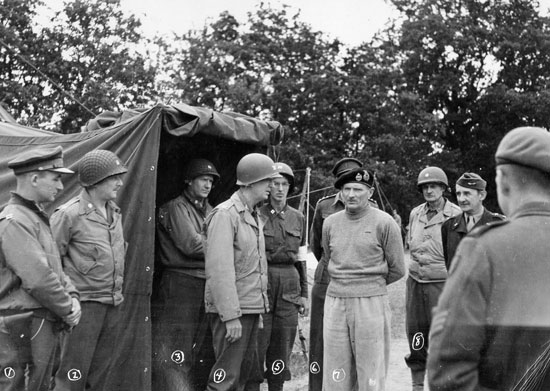
Official visit by Field Marshal Bernard L. Montgomery to the 2d Evacuation Hospital in July 1944. Picture taken during the unit’s stay at La Mine, France, from 28 June 1944 until 11 August 1944. From L to R: unknown, Lt. Colonel Gerald D. Dorman, Lt. Colonel John S. Davis, Colonel Wm F. MacFee, Captain Margaret D. Prietzel, unknown, Fld. Marshal Bernard L. Montgomery, Lt. Colonel M. K. Smith, unknown, British NCO (Monty’s staff), (photo courtesy VMI Archives).
In the first few days following opening, patients arrived in large numbers, plunging the Hospital at once into full activity. On 17 July 1944, 4 Officers were transferred to Infantry Divisions which was particularly hard to accept since the personnel had no lack of work at all. On 26 July, however, 2 Officers, accompanied by 2 Nurses and 2 Enlisted Men of the 2d General Hospital were attached for temporary duty as shock teams, and on 27 July, 3 additional Officers, 1 Nurse, and 2 EM pertaining to the Third Auxiliary Surgical Group joined the 2d Evac as an operating team. The latter remained until 3 August 1944 giving the unit precious help. The shock team members stayed until 11 August.
Early in August, the 5th Evacuation Hospital, which had been operating nearby, closed and sent 40 of their non-transportable patients to the 2d. On 7 August 1944, the 2d Evacuation Hospital closed for patients, and started preparations for its next move.
During the nearly six-week stay at La Mine, Basse-Normandie, there were 5,263 admissions, 3,238 operations, and 63 deaths. Of the deaths, 47 were post-operative and 1 succumbed during induction of anesthesia. The high patient census was handled with 12-hour shifts which helped the unit to function smoothly and efficiently. Casualties received belonged to the 1st – 2d – 29th – and 30th Infantry Divisions.
While being stationed at La Mine, the personnel grew accustomed to French currency, French customs and habits, and had their first taste of champagne – cognac – wine – and calvados, and found the Army Guide books concerning the French language put to some extensive use. French kids often invaded the area looking for crackers, biscuits, chocolate bars, or a “cigarette for Papa” …
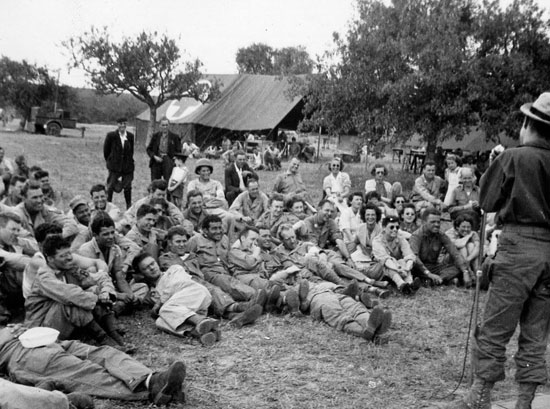
G.I. audience watching a USO show while bivouacking at Senonches, France. Picture taken in September 1944 (photo courtesy VMI Archives).
At 0920, 11 August 1944, the Hospital moved to Mesnil-Clinchamps, northwest of Vire. One Officer, 4 Nurses and 11 Enlisted Men remained to care for 25 non-transportable patients; and would re-join the organization 11 August. The unit reached its new location at 1115 hours the same day and opened the following day.
On 13 August, Colonel W. F.MacFee left for the Zone of Interior on detached duty and Colonel John S. Davis, Jr., MC again assumed temporary command. On 15 August, a detachment of 40 German PWs arrived for general works about the camp and this proved a satisfactory arrangement which continued until the next move to a bivouac area. One ANC Officer and 3 Medical Officers were added to the staff. As the war was moving so swiftly it soon left the 2d in its wake. Consequently the Surgeon, First US Army ordered the Hospital to close again on 19 August 1944 (a few stragglers were still admitted on 20 August).
On 22 August 1944, 17 non-transportable patients were turned over to a Platoon of the 621st Medical Clearing Company, which set up a tent on the grounds to care for them. On the 25 of August, the 2d Evac left Mesnil-Clinchamps and reached the medical concentration area at Senonches the next morning after an all-night truck ride. Only housekeeping arrangements were set up while the unit rested and awaited orders for another move to some locality where further medical services were required.
In the period of operation at Mesnil-Clinchamps, 1,381 patients were admitted. There were 450 operations and 13 deaths.
As it turned out the stay at Senonches lasted longer than foreseen, but it proved to be a pleasant interlude notwithstanding the wasps which delighted in buzzing around the food and making pests of themselves. After a while the inactivity got boring and everybody was anxious to begin work again. On 4 September 1944, the second anniversary of the organization’s departure from the United States was observed. On 11 September, Colonel J. S. Davis, Jr. left with an advance party with the expectation that the 2d was soon to move to Eupen in eastern Belgium. On 15 September, the CO, Colonel W. F. MacFee, was back with the unit. His duty had taken him to Washington D.C. on a mission concerning the supply of stored blood directly from the US to overseas Theaters. He had flown the Atlantic both ways.
Belgium:
Finally, early in the morning of 27 September 1944, the Hospital was transported by motor convoy to Eupen, Belgium, while supplies went by train to Liège, Belgium. The first stop was at Soissons, and the end of the second day’s run completed the 365-mile trek to Belgium. At Eupen, the advance detail had procured a large Sanatorium overlooking town. The modern building had been used by the Germans to treat soldiers with tuberculosis. It was designed for 200 patients only, which necessitated additional tent wards to augment the bed capacity. Most floors were used for medical purposes, with Nurses and senior Officers housed on the first floor. Ambulatory patients were set up on the fourth floor, as the existing elevators only reached the third floor. The receiving ward was installed outside the building under tentage as well as the pre-operative cases and early post-operative evacuees. Junior Officers were quartered in the staff building and the Enlisted personnel were housed in pyramidal tents across the street. A good deal of help was needed from the Engineers, but despite breakdowns and other problems, the building was warm and dry and beautifully situated.
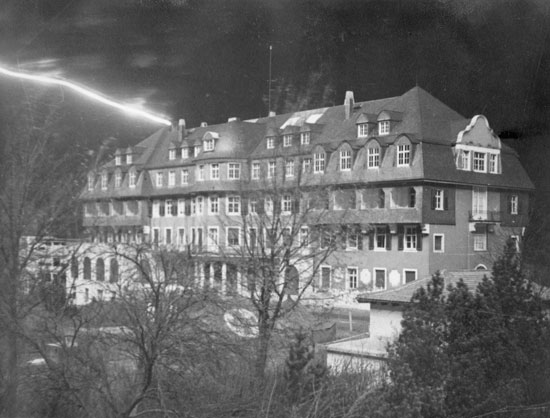
Picture taken 19 December 1944 from the Officers’ quarters, 2d Evacuation Hospital, Eupen, Belgium, during a German air raid on the city. A flare is visible in the upper left corner of the picture (photo courtesy VMI Archives).
Operations
The 2d Evacuation Hospital opened for patients 2 October 1944. For the first five days it operated as a transfer point, as well as an evacuation facility. During this period, a total of 1,885 transfers were received, a number of whom had to be retained for further treatment before continuing their way to the next echelon of the evacuation route. The transfer point stopped operations on 6 October. In the succeeding two weeks the 2d Evac received the greatest concentration of seriously wounded that it had experienced during the current year. Aachen, Germany, was one of the big objectives at that time and the fighting for it was bitter and intense. Patients arrived constantly in a steady stream. After its fall, pressure lessened. During the organization’s stay in Eupen, Belgium, buzz-bombs (V-1 flying bombs –ed) seemed to converge over the area regularly, causing terrific noise and rattling the windows of the buildings as they passed overhead.
Major General Paul R. Hawley, Chief Surgeon, ETOUSA, inspected the Hospital on 18 October. Other distinguished visitors since then included Lady Louis Mountbatten, Admiral Richard E. Byrd, and other Allied dignitaries.
The month of November saw an increase in the number of operations as compared to October, but not as many seriously wounded, with the result that deaths decreased. One outstanding feature however, was the large number of traumatic amputations due to landmines and booby-traps.
On 2 November, the unit lost 1 Nurse, transferred to the 107th Evacuation Hospital; on 16 November 1944, 2 Nurses were transferred to the 102d Evacuation Hospital. First Lieutenant Ruth H. Meinecke, ANC succeeded Captain Edith G. Byram, ANC as the unit’s Asst. Chief Nurse. The organization gained 1 Nurse, transferred from the 102d Evac.
A new type of casualties was received throughout the last three months of 1944. They involved patients suffering from trench foot. 1,151 such cases were received in November, and 984 in December.
On 16 December, enemy shells began landing in the immediate area, and in the evening German planes droned overhead, dropping bombs on the city. The Germans were making their desperate counteroffensive and breakthrough attempt! Despite the opening of the German Ardennes Offensive, the unit had fewer admissions and did fewer operations, although there was a decided increase in daily admissions over the following days. Since the initial shelling of Eupen on the night of 16 December, the town had been shelled again on one occasion, bombed six times, and strafed three times. Meanwhile medical installations in Eupen were pulled out. The 2d Evac Hosp was selected to remain, in spite of some German paratroops dropped by the enemy in and around Eupen. German forces pushed down to within five miles of the Hospital and the 5th Armored Division set up roadblocks behind it to stop the Germans should they overrun the position. In the latter part of December, 57 non-transportable wounded were received from the 5th and 45th Evacuation Hospitals, when those outfits pulled out of Eupen. Total evacuation was put into effect on 21 December 1944.
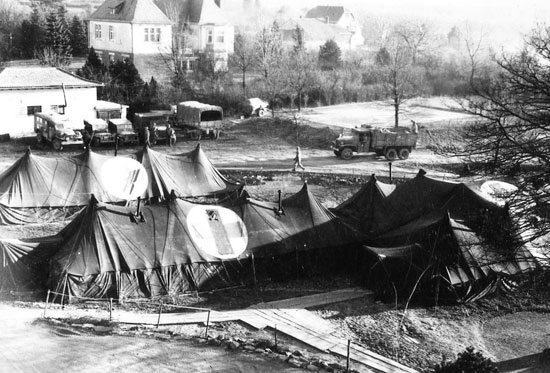
Partial view of Admission tents with Officers’ quarters in the background. Picture taken in Eupen, Belgium, December 1944 (photo courtesy VMI Archives).
The 2d gained 1 Officer and 1 Nurse on 22 and 25 December, but lost 3 Officers to the 102d Evacuation Hospital, the 464th Medical Collecting Company, and the 16th General Hospital between 18 and 26 December 1944.
Captain Orion Page, MAC, O-187083, the unit’s Mess Officer was awarded the Bronze Star Medal for meritorious service in connection with military operations against the enemy, from 19 June to 14 September 1944, in England and France, per Section III, General Orders No. 102, Headquarters, First United States Army, dated 28 December 1944.
At length, events returned to normal; the Allied Armies erased the enemy breakthrough threat and were now pushing the Germans back towards the Rhine River. When the Hospital finally closed, a recap showed that a total of 30,734 patients had been admitted of which 199 died. A total of 4,878 operations were performed. The organization had been open for 143 consecutive days, the longest period of continuous operation of any First Army Hospital.
Special notes: following data are related to the stay of medical units in Eupen, Belgium in fall/winter of 1944-1945.
Starting September 1944 a number of buildings in the city of Eupen were requisitioned and occupied by various American medical units, who used them for storage (open and closed), bivouacs, workshops, garages, offices, recreation rooms, messes, and billets. All of them were duly registered with a Certificate of Occupancy, signed by the responsible US Officer and the local Burgomaster or his representative. The units occupying them were:
2d Evacuation Hospital
45th Evacuation Hospital
57th Medical Battalion
591st Motor Ambulance Company
Headquarters & Headquarters Detachment, 177th Medical Battalion
427th Medical Collecting Company (Separate)
Headquarters & Headquarters Detachment, 91st Medical Gas Treatment Battalion
5th Evacuation Hospital
A Company, 91st Medical Gas Treatment Battalion
The first buildings were requisitioned starting 27 September 1944, with the last one being occupied as from 1 June 1945. All requisitioned locations were vacated 28 August 1945.
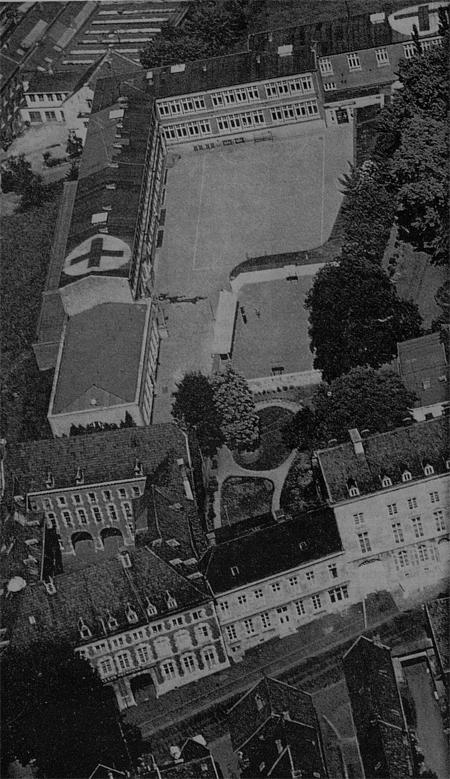
Aerial view of “Sanatorium” illustrating the large GC markings on the roof of the building. Courtesy Staatsarchiv Eupen.
Germany:
The 2d Evacuation Hospital departed from Eupen, Belgium, on 31 March 1945 moving to Zülpich, Germany, where they were housed in a German institute for the insane. Nuns cared for the inmates. While there, the Remagen Bridgehead and subsequent crossings of the Rhine had placed the American Armies far ahead of the Hospital. Consequently the next move was made per truck and C-47 transport planes to Kassel, Germany, on 14 April 1945. As the advance continued, the organization eventually moved further into Germany to finally set up at Naumberg, approximately thirty miles southwest of Leipzig. While traveling through German towns and villages, the attitude of the population remained cold and forbidding. Extensive bomb damage and shelling had reduced many homes and buildings to mere heaps of stone and rubble. Civilians just stood there and stared, as though they couldn’t grasp the significance of what was happening to the crumbling Reich! Germany was defeated…
The 2d arrived at Naumberg on 16 April 1945, and set up the Hospital in a former Germany military barracks. It proved an ideal location and within two days, the staff was ready to receive patients. At the same time, many of the personnel who had been placed on TDY returned to the unit; most of them had been serving in overrun German Military Hospitals, caring for American and Allied soldiers as well as DPs. On 20 April 1945, Colonel William F. MacFee, MC was transferred to Fifteenth United States Army and Lt. Colonel John S. Davis, Jr., MC took over command of the organization.
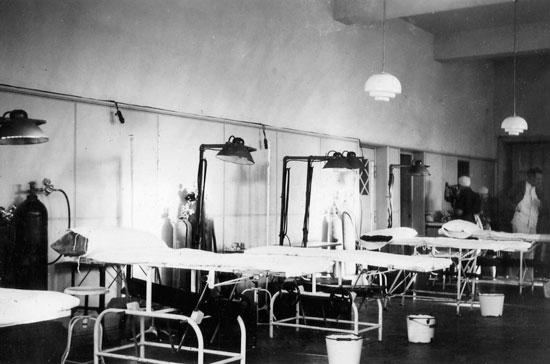
Partial view of the Operating Room while the 2d Evacuation Hospital was stationed in Eupen, Belgium. Picture taken in October 1944 (photo courtesy VMI Archives).
While operating at Naumberg (until 22 June 1945 –ed), the 2d Evac admitted a large number of RAMPs and DPs necessitating urgent medical care as many of them were in extremely poor physical condition, suffering from malnutrition and disease. After evacuating their last patients, the unit departed Naumberg on 24 June 1945 by motor convoy to the medical concentration area at Rodheim, Germany, some 3 ½ miles northwest of Gießen. Between 7 and 22 June, the 2d had admitted a total of 44,552 patients with 25 deaths recorded.
The End:
There were several Officer promotions, notably that of Majors Warren B. Spurge and William S. Norton, II to Lt. Colonel. In addition, there were numerous gains and losses among the Enlisted personnel. 19 EM and 2 Officers were returned to the Zone Interior during the month. 21 Bronze Star Medals were awarded to Medical Officers, Nurses, and Enlisted Men of the unit, but no presentation was arranged. It was planned that the recipients would receive the awards during an official ceremony in July. Some more Officers were placed on temporary duty the last days of the month of June, with the 8th Convalescent Hospital and the Surgeon’s Office, XIX Corps. The unit was eventually placed in Category II for a short period and, because it had a great majority of high-pointers, it appeared that there would be a mass evacuation of personnel. However, before the month’s end, the 2d Evac Hosp received notification that it had been changed to Category IV.

Photo of RAMP while being treated at the 2d Evacuation Hospital, Eupen, Belgium, 11 March 1945. Private Warren L. Steger, ASN 33822781, Co B, 134th Inf Regt, 35th Inf Div, age 19, captured near Arlon, Belgium, 4 January 1945, while his unit helped relieve Bastogne, and released 10 March 1945, near Bonn, Germany. He was down with jaundice, very weak, and unable to walk for three weeks prior to his liberation by American forces (photo courtesy VMI Archives).
On 18 July 1945 the Hospital moved from its bivouac area near Gießen, Germany, to Fulda, where it started operations on 19 July. The organization was located in a Catholic Krankenhaus, formely in use by the Wehrmacht with a 200-bed capacity that could be expanded to 300.
A number of the personnel with low points or who desired to continue in the service were exchanged with the 51st Evacuation Hospital.
10 high-point Officers returned to the United States by air, including Lt. Colonel John S. Davis, Jr. (Commanding Officer); Lt. Colonel John West (Chief of Surgical Service); and Lt. Colonel William S. Norton, II, MC (Chief of Medical Service). Following their departure, Major Duncan R. McCuaig, MC assumed command of the Hospital, while Major Robert W. Fraser, MC became Chief of Surgical Service, and Captain Hector Perrone, MC was appointed Chief of Medical Service.
During their service overseas, the 2d Evacuation Hospital received and treated over 49,000 patients. The War in Europe being over, some of the men were leaving the organizationh under RR-1 plans to return to the Zone of Interior. The unit accomplished its task, that of caring for the wounded, sick, and injured and thoughts of home and loved ones were now uppermost in everyone’s minds…
The 2d Evacuation Hospital was finally inactivated at Camp Myles Standish, Massachusetts, on 22 November 1945(Ref. AG 322 (20 Sep 45), OB-I-SPMOU-M, dated 24 September 1945, Army Service Forces, Boston Port of Embarkation, Massachusetts, Cp. Myles Standish, Massachusetts, dated 22 November 1945).
Stations – 2d Evacuation Hospital (temporary or permanent)
Fort Devens, Ayer, Massachusetts (22 Jan 42 > 21 Jul 42)
Camp Kilmer, Stelton, New Jersey (21 Jul 42 > 4 Sep 42)
Sea voyage ZI – UK (5 Sep 42 > 11 Sep 42)
Waringfield, Northern Ireland (12 Sep 42 > 26 Oct 42)
Ballymena, Northern Ireland (12 Sep 42 > 26 Oct 42)
Frenchay Park Hospital, Bristol, England (26 Oct 42 > 11 Nov 42)
Musgrove, Taunton, England (26 Oct 42 > 7 Dec 42)
Diddington, Huntingdonshire, England (26 Dec 42 > 1 Aug 43)
Crookston, Scotland (1 Sep 43 > 25 Oct 43)
Cowglen, Lanarkshire, Scotland (26 Oct 43 > 16 Feb 44)
Whitchurch, Glamorganshire, South Wales (17 Feb 44 > 10 Jun 44)
Remenham, Berkshire, England (10 Jun 44 > 19 Jun 44)
La Cambe, Basse-Normandie, France (23 Jun 44 > 28 Jun 44)
La Mine, Basse-Normandie, France (28 Jun 44 > 11 Aug 44)
Mesnil-Clinchamps, Basse-Normandie, France (12 Aug 44 > 19 Aug 44)
Senonches, Center Region, Northern France (26 Aug 44 > 27 Sep 44)
Eupen, Eastern Belgium (28 Sep 44 > 31 Mar 45)
Zülpich, Germany + Naumberg, Germany + Fulda, Germany

Picture of the Admission Tents of the 2d Evacuation Hospital, Eupen, Belgium. After 185 days of operation, the unit closed in Belgium and started preparations for its transfer to Germany (photo courtesy VMI Archives).
Overseas Wartime Assignments – 2d Evacuation Hospital
November 1943 > assigned to First United States Army (attached to SOS, ETOUSA) as per Paragraph 3, Letter 322 (C), Headquarters, First US Army, dated 6 November 1943
January 1944 > relieved from assignment to First United States Army and assigned to VIII Corps, attached to First US Army, as per Paragraph S, Letter AG 322 MGC, Headquarters, European Theater of Operations, dated 22 January 1944
March 1944 > relieved from assignment to VIII Corps, attached to First US Army, and assigned to First United States Army, as per Paragraph 2, Troop Re-Assignment Order No. 1, Headquarters, European Theater of Operations, dated 13 March 1944.
Statistics – 2d Evacuation Hospital (Dec 1942 > Dec 1943)
Admissions – 3,544
Dispositions – 3,103
Operations (skin & subcutaneous tissue) – 489
Operations (eye, ear, nose & throat) – 210
Operations (circulatory system) – 104
Operations (respiratory system) – 3
Operations (digestive system) – 314
Operations (genito-urinary system) – 204
Operations (nervous system) – 18
Operations (muscular system) – 102
Operations (lymphatic system) – 9
Operations (endocrine system) – 1
Operations (dental) – 3
Operations (bones, joints & bursae) – 653
Total AAF casualties received numbered 198, and patients receiving first definitive treatment at the 2d Evac totaled 176. Twenty-three (23) operations led to complications and 6 deaths were recorded.
Partial Statistics – 2d Evacuation Hospital (Jun 44 > Dec 44)
Admissions – 27, 250
Operations – 8,566
Deaths – 275
Highest Census – 687 (30 Jul 44)
Largest Number of Operations – 214 (28 Jul 44)
Commendations – 2d Evacuation Hospital
The 2d Evacuation Hospital received a first Letter of Commendation from Headquarters, 1st Bomb Wing, Eighth United States Army Air Force, Office of the Surgeon, APO 634, dated 14 August 1943, for taking care of the wounded and sick personnel of the 1st Bomb Wing from December 1942 to August 1943 while stationed in England. The Letter of Commendation, reference M-A-3, was signed by Lt. Colonel A. L. Streeter, MC, Wing Surgeon.
The 2d Evacuation Hospital received a Letter of Commendation from Headquarters, United States Strategic Forces in Europe, AAF 379, APO 633, dated 16 April 1945, for the high quality of professional care rendered resulting in the saving of many lives and the speedy recovery and prompt return of patients to their units. The Letter was signed by General Carl A. Spaatz, Commanding General, who expressed his gratitude for the medical care furnished to Army Air Force personnel (forwarded via 12th Army Group).
An additional Letter of Commendation was received from Headquarters, First United States Army, APO 655, dated 27 April 1945, and signed by Brigadier General R. B. Lovett, Adjutant General.
World War 2 – Campaign Credits
Normandy
Northern France
Rhineland
Ardennes-Alsace
Central Europe

Commemorative plaque dedicated to the 2d Evacuation Hospital by the the parishioners of Whitchurch, South Wales, United Kingdom.
The MRC Staff are truly indebted to Lynn F. McNulty, who once more provided them with copies of official Unit Reports enabling them to edit a concise Unit History of the 2d Evacuation Hospital for their web pages. Our heartfelt thanks Lynn. A number of original pictures contained in the above document were obtained via Michael A. Salamone, son of Sergeant Lawrence F. Salamone (ASN:31016490) who served with the unit in the ETO. Mike was also instrumental in providing us with vintage photographs from George G. Nelson Jr., nephew of Captain Charles F. Schetlin, MC and Lieutenant Mary S. Nelson, ANC who both served with the Hospital, and further helped us obtain a number of photos from the John L. Couper Papers, courtesy the Virginia Military Institute Archives, including some from St. Luke’s and Roosevelt Hospitals, New York, as well, allowing them to illustrate the above Unit History. Additional data relating to the occupancy of requisitioned buildings by US medical units were thankfully received from Frau Els Herrebout, Leiterin Staatsarchiv Eupen, Belgien. Thank you all for your kind contributions.
